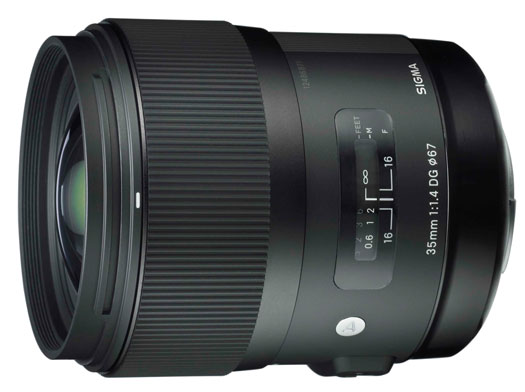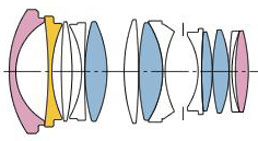Sigma 35mm f1.4 Art review
-
-
Written by Thomas
Intro
The 35mm f/1.4 DG HSM is Sigma’s first large aperture 35mm full-frame lens. It was announced November 2012 and goes head-to-head against the equivalent offerings from Nikon, Canon and Sony.
As Sigma’s first lens to define its “Art” product line (the others being “Contemporary” and “Sports”) it is expected to “focus on sophisticated optical performance and abundant expressive power”. It is available in Sigma, Nikon, Canon, Sony, and Pentax mounts. As usual the price of the Sigma is lower (and considerably so) than 35mm f1.4 options from Canon, Nikon and Sony so the real question is whether the optical performance of this lens can match or even surpass the competition from the big boys.
In my Sigma 35mm f1.4 review I’ll put this lens to the test on a 36MP Nikon D800 body to see whether it’s a good match for the highest resolution full-frame DSLR. In preparing this review I also did a lot of comparable shooting with the Nikon 35mm f1.4G who’s review I’ll be updating shortly, so I’ll be able to tell you the pros and cons of both models to help you choose which will be the best lens for Nikon users.
 |
Facts from the catalog
As usual I’ll have a look at the technical data first. I’ve rated the features with a [+] (or [++]), when it’s better than average or even state of the art, a [0] if it’s standard or just average, and [-] if there’s a disadvantage.
 | |
As usual I’ll have a look at the technical data first. I’ve rated the features with a [+] (or [++]), when it’s better than average or even state of the art, a [0] if it’s standard or just average, and [-] if there’s a disadvantage. Most features are compared to Nikon’s AF-S 35/1.4G and Canon’s EF 35/1.4 L USM (simply called “the Nikkor” and “the Canon” in this paragraph).
Size (diam. x length): 77 x 94 mm (3 x 3.7 in.). A little slimmer and longer than the Nikkor/Canon. [0]
Weight: 665 g (1.5 lb.). 10/15% heavier than the Nikkor/Canon. [0]
Optics: 13 elements in 11 groups. That’s quite a lot for a fixed focal lens (the Nikkor has only 10 elements in 7 groups). 22 air/glass-surfaces provide a lot of opportunities for flares and ghosts. The lens contains one aspheric and six special low-dispersion elements. [0]
Closest focus distance/max. magnification: 30 cm (11.8 in.) / 1:5.2. That’s almost identical to the Nikkor/Canon. [0]
Filter-thread: 67mm = a smaller version than the 77mm standard of many pro-lenses. Allows for cheaper filters and is the same as with the Nikkor, the Canon needs 72mm filters. [+]
Image stabilization: No, same as with the Nikkor/Canon f1.4 models! At 35mm focal length not really a critical feature for still shooting, but desirable for video and it’s worth noting Nikon offers a stabilized 16-35mm zoom and Canon has the EF 35mm 2.0 IS USM. [0]
AF: HSM (hyper sonic motor), so it does work on Nikon D60/3×00/5×00-bodies w/o AF-motor. Manual-focus override by simply turning the focus ring [+]
Covers full frame/FX or smaller = very good [+]
Price: around 850 EUR new (incl. 19% VAT) = not cheap. But the Canon is 50% and Nikkor even 70% more expensive. See above for the latest pricing. [+]
Comes with a nice semi-soft lens-case that is well padded but has no strap, the lens-shade is included, reversible for transport, and the lens-caps are similar to Nikon’s. [+]
Distance information is relayed to the camera, so the Nikon body can do all the advanced exposure-related stuff with this lens. [+]
Aperture ring = no, just like all competitors. [0]
Sealing: no! The Nikkor and Canon are weather-sealed with rubber grommets at the lens-mount. [0]
The score in the “features-department” is 0[-]/7[0]/6[+]. There is no real fault to be found with the features of this lens other than lack of weather sealing, but there is one big plus: it is by far the cheapest way to get a 35/1.4 lens that does AF for all Nikon bodies.
Motivation
:
35mm is a very interesting focal length! On both a DX/APS-C and a full-frame body it can be considered a standard lens as its focal length is pretty close to the diagonal of the sensor (28mm with DX/APS-C, 42mm with full-frame) giving you a very natural look. And even on a full-frame body 35mm does not distort people standing next to the border of the frame like shorter focal lengths. All-in-all 35mm is something of a street-shooters standard lens that – combined with its large aperture – can capture moments of life while being in the middle of it without being intrusive.
Alternatives
:
– First there are the respective 35mm f1.4 lenses from Nikon, Canon and Sony.
– If you don’t need AF there’s a manual focus lens from Samyang which is the cheapest way to get a 35mm f1.4 lens and the Zeiss ZF.2 Distagon T* 35mm 1.4 which is the most expensive of the bunch.
– There are more alternatives for DX/APS-C bodies, like the Nikon 35/1.8G or the new Sigma 30/1.4 DC HSM. Those lenses can also be used on a full-frame body but you have to crop 1.2-1.5x to get rid of the vignette.
– And if you are willing to forfeit the f1.4/f1.8 aperture there are 35mm f2.0 lenses from Nikon, Zeiss, and Canon, the latter even offering Image Stabilisation in its latest guise..
Focus, build quality, and image stabilization
Focus accuracy and repeatability is critical to consistently produce sharp shots. Repeatability (the accuracy of focus on the same subject after repeated focus-acquisition) of this lens is good with no real outliers over a series of 40 shots. And the lens focuses pretty fast: around 0.6-0.7 sec from infinity to 30 cm, which is a good value.
The focus ring has no slack/play between its movement and the focus-action and a throw of around 70 degrees, which is a little short for accurate focus wide open. The focus ring is easy to grip but movement is pretty stiff. AF-operation is barely audible from the outside, but if you record video with the built-in microphone focus-movement starts and stops with mild “clack” although the AF-drive itself is not too annoying. Shaking the lens produces little noise.
In general the impression of build quality is that of a pro-level lens: A high quality metal/plastic construction with nine rounded aperture blades. Only weather sealing is missing.
Now it’s time to check out the results in my Sigma 35mm f1.4 quality and Sigma 35mm f1.4 sample images pages, or if you’d like to skip to chase, head straight for my verdict!
 The Sigma 35/1.4 DG HSM is a very exciting lens. You can produce shots with image quality you might think were impossible at a wide open aperture of f1.4. Plus the build-quality and the new design support Sigma's claim to have developed and manufactured a lens to professional standards. I was quite shocked to see this lens surpass the optical performance of the venerable Nikon AF-S 35mm f/1.4G with respect to sharpness.
But in other respects it slightly lags Nikon's flagship: rendering of out-of-focus subjects in the background is a bit more nervous than from the Nikkor which also shows a higher resistance against flare and glare. There's also no weather-sealing which seems a bit out of place for a lens targeted at professionals. But mind you even in these aspects of lens-performance the Sigma plays on a very high level - and it does deliver this impressive performance at a price that is much lower than the 35mm f1.4 models from Nikon, Canon or Sony.
The Sigma 35/1.4 DG HSM is a very exciting lens. You can produce shots with image quality you might think were impossible at a wide open aperture of f1.4. Plus the build-quality and the new design support Sigma's claim to have developed and manufactured a lens to professional standards. I was quite shocked to see this lens surpass the optical performance of the venerable Nikon AF-S 35mm f/1.4G with respect to sharpness.
But in other respects it slightly lags Nikon's flagship: rendering of out-of-focus subjects in the background is a bit more nervous than from the Nikkor which also shows a higher resistance against flare and glare. There's also no weather-sealing which seems a bit out of place for a lens targeted at professionals. But mind you even in these aspects of lens-performance the Sigma plays on a very high level - and it does deliver this impressive performance at a price that is much lower than the 35mm f1.4 models from Nikon, Canon or Sony.



